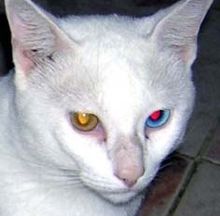Red-eye effect
With red-eye effect or red-eye effect refers to the appearance of red pupils in images of living creatures, with flash light were photographed.
root cause
The effect occurs when the flash unit is mounted almost on the same axis as the lens , i.e. is close to the optical axis . It is caused by the reflection of the lightning through the red retina of the eye, which is well supplied with blood . If the person looks directly into the lens, the effect is particularly noticeable, but generally occurs whenever the flash light reflected on the retina falls back in a straight line into the lens.
Avoidance
The effect can be influenced with the help of various flash methods . A remedy is to move the flash unit as far out of the optical axis as possible. This enables, for example, the use of a stick flash attached to the side of the camera or techniques such as the unleashed flash , in which the flash units are placed freely in the room; the disadvantage here are enlarged cast shadows . Alternatively, the flash can also be "deflected" so that it does not fall directly on the eye of the photo subject. This can be achieved, for example, by turning the flash against the ceiling. Another possibility of supplying more light to the object or person is to use additional light sources.
The problem does not normally arise in professional flash photography or when using a studio flash system , since the light sources are usually placed far away from the optical axis. In amateur photography , on the other hand, the effect is more common, for example when using the built-in mini flash unit of a compact camera or when attaching a compact flash unit to the hot shoe of a camera.
Modern cameras and flash units often try to reduce the red-eye effect with a pre-flash . This reduces the pupil opening of the eye and the reflection of the flash light on the retina . However, the reduced pupil is undesirable in the interest of achieving an appealing portrait , since it is known from behavioral biology and perceptual psychology that images of people with small pupils are perceived as less sympathetic and friendly. A pre-flash can only effectively prevent red-eye if the person is not looking directly into the lens or at the flash.
Eliminate the red-eye phenomenon
During image processing, the red-eye effect can be recolored in a relatively uncomplicated manner , both in the photo laboratory by darkening and using the aids of digital image processing.
The illustration shows four phases of editing with Photoshop:
- At the top of the picture you can see the original picture.
- A new adjustment layer is created over the original image. The channel mixer is selected as the setting type, with which the color channels are set as follows: red channel = 0%, green channel = 50%, blue channel = 50%.
- Image three shows the effect of a black filled layer mask inserted into the adjustment layer: The effect of the adjustment layer is masked away, so this image corresponds to the first.
- In image four, the pupil as it looks in the adjustment layer was exposed by painting over it white with the brush tool in the layer mask. (White areas in the layer mask make the corresponding parts of the layer fully visible.)
annotation
If, especially in a newborn, baby or toddler, the red-eye effect does not occur on one or both sides, but instead a glowing white pupil can be seen, this may be an indication of the presence of a retinoblastoma (a malignant eye tumor) or a horror Be the stars of the newborn. Only by acting quickly is there a chance of maintaining the eyesight of the affected eye.
Animals
A similar effect occurs in a number of animal species. In animals that have to see well in the dark, the tapetum lucidum is located behind the retina of the eye , which reflects incoming light so that it has a second chance on the way back to trigger a nerve impulse in the visual cells . The rest of the light exits through the pupil and leads to very bright eyes. The phenomenon of cats is particularly well known, which is why light reflectors are also called cat eyes .



